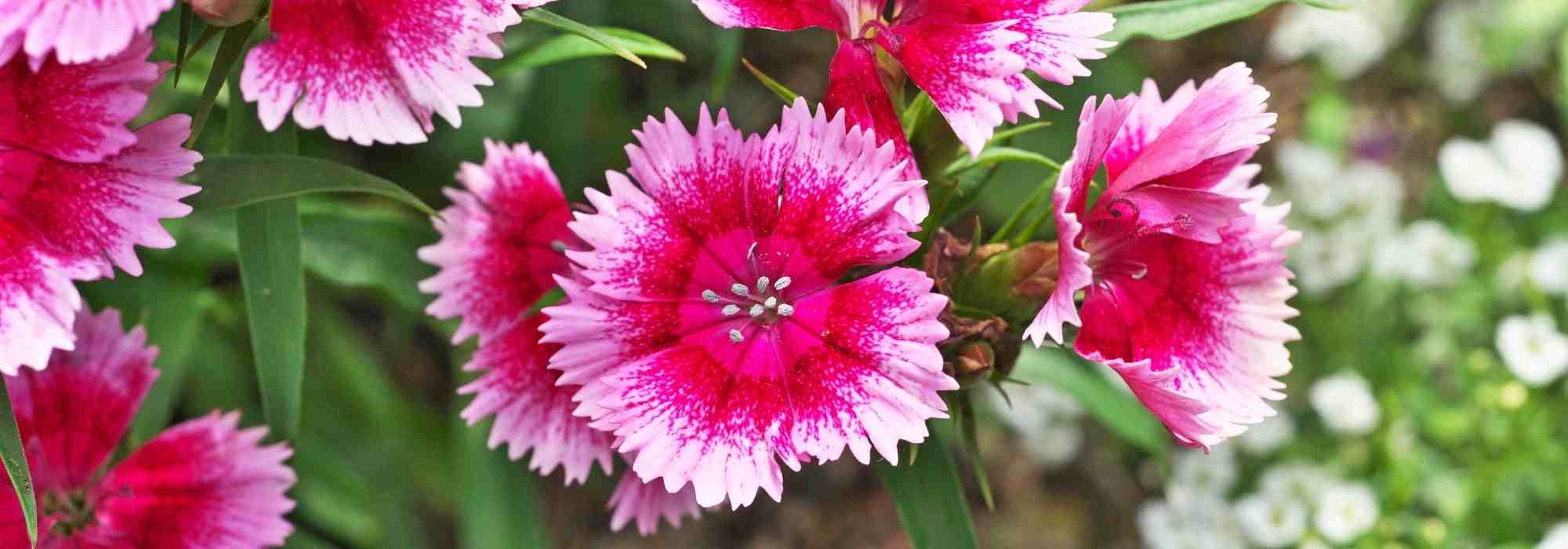
Choosing a carnation
Our buying guide
Contents
Whether perennial, annual, or biennial, the Carnation always makes a statement with its vibrant flowers! With around 300 species of Dianthus perennials and thousands of horticultural varieties, choosing a Carnation can be more complicated than one might think. Versatile and easy to grow, they offer multiple uses in sunny situations, whether in the garden or in a flowering pot on the balcony or terrace. Valued for their fragrant flowers in a variety of colours and shapes, Carnations are perfect for creating bouquets. Whether in cushions or more upright, dwarf or large, with long or short lifespans, flowering periods, and hardiness, here are some tips to help you choose your Carnation based on different criteria.
Also, discover our complete guide Carnation: planting, care, and sowing tips
According to the colour of the flowers
Highly floriferous, Carnations offer us magnificent blooms in various colours: white, pink, red, yellow, as well as bicolour and multicolour. The shades are very diverse. With a rustic and bucolic style, they sometimes reveal delicate coloured details on their petals: fine edges, striations, or irregular spots. There is something for everyone. Here is an overview of the different existing colours:
White-flowered carnations
The Dianthus with white flowers are immaculate, with a very pure white, like the Land Carnation ‘Albiflorus’ shining in the sun. Sometimes, the heart of the flowers is slightly tinted: the Dianthus plumarius ‘Haytor White’ reveals a cream-coloured heart, while the Mignardise Carnation ‘Mrs Sinkins’ has a very light green centre.
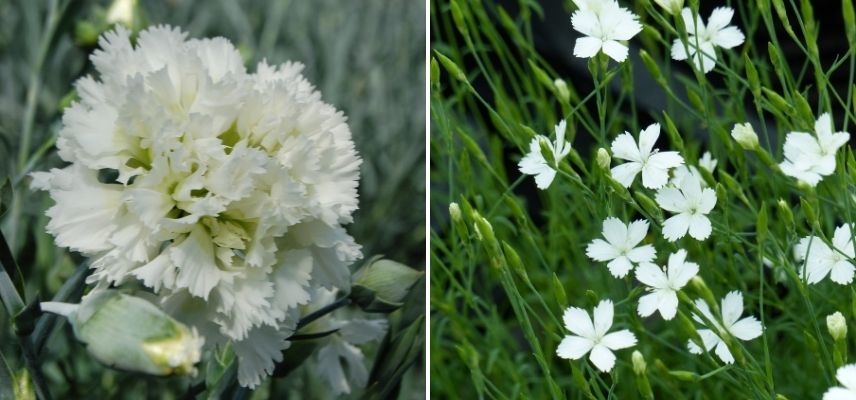
Dianthus plumarius ‘Mrs Sinkins’ and Dianthus deltoides ‘Albiflorus’
Pink-flowered carnations
The species and varieties with pink flowers are very numerous. In salmon-pink and coral tones, the Dianthus ‘Scent First Coral Reef’ and the Mignardise Carnation ‘Doris’ are stunning. Very light, the Dianthus spiculifolius, the ‘Scent First Iced Gem’ Carnation and the Dianthus plumarius ‘Pike’s Pink’ are of incomparable softness. Very bright, the Pentecost Carnation ‘Splendens’ and the Annual Carnation ‘Suntory Pink’ add a pop of colour to borders and pots. Finally, other Dianthus have a pink leaning towards mauve or red, such as Dianthus ‘Pop Star’ and Dianthus plumarius ‘Munot’.
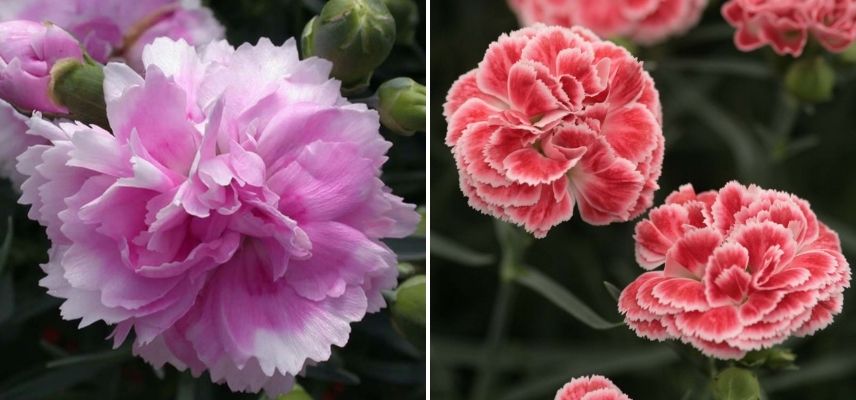
Dianthus ‘Scent First Iced Gem’ and ‘Scent First Coral Reef’
Red-flowered carnations
Symbolising passion, the red Carnation exists in many shades. The Dianthus plumarius ‘Lady in Red’ and Dianthus ‘Fusilier’ are very intense and vivid. Leaning towards burgundy red, the Poet’s Carnation ‘Sooty’ is very dark. Others, like Dianthus gratianopolitanus ‘Bombardier’ and the Pentecost Carnation ‘Badenia’ are a mix of red and pink.
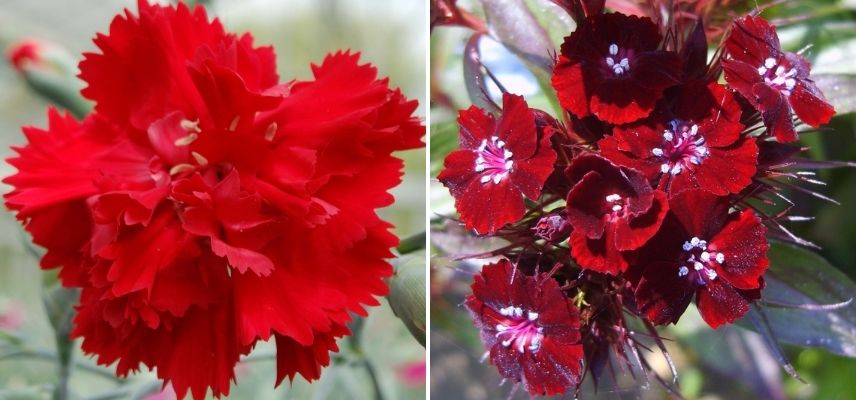
Dianthus plumarius ‘Lady in Red’ and Dianthus barbatus nigrescens ‘Sooty’ (photo Trisha)
Yellow-flowered carnations
Yellow is a rather rare colour among Carnations. In totally different styles, we find the Dianthus plumarius ‘Devon Cream’ with double cream-yellow and ivory flowers, sometimes subtly tinted with pale pink and with frilled petals, as well as the Knapp Carnation with simple flowers of five petals in a beautiful light yellow.
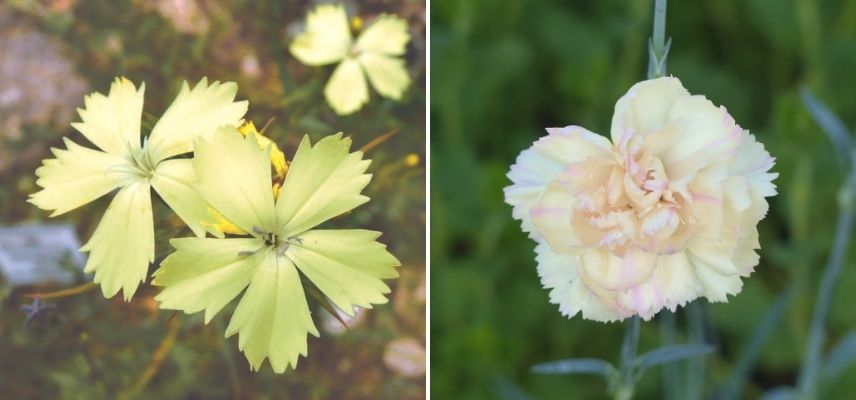 Dianthus knappii and Dianthus plumarius ‘Devon Cream’
Dianthus knappii and Dianthus plumarius ‘Devon Cream’
Bicolour or multicolour carnations
Very original and varied, bicolour or multicolour Carnations are true masterpieces, here are a few examples:
- The Mignardise Carnation ‘Devon Magic’ is beautifully striped with light pink and rose bengal
- Multicoloured, the Mignardise Carnations ‘Gran’s Favourite’, ‘Moulin Rouge’ and ‘Laced Monarch’ have petals delicately edged with a coloured line
- The Mignardise Carnation ‘Sugar Plum’ and the Grenoble Carnation ‘Whatfield Gem’ are perfectly spotted with bright pink and light pink
- Finally, there are many bicolour Carnations with dark centres: Dianthus plumarius ‘Ine’ and ‘Maggie’, ‘Raspberry Sundae’ and ‘Coconut Sundae’ and Dianthus allwoodii ‘Alice’
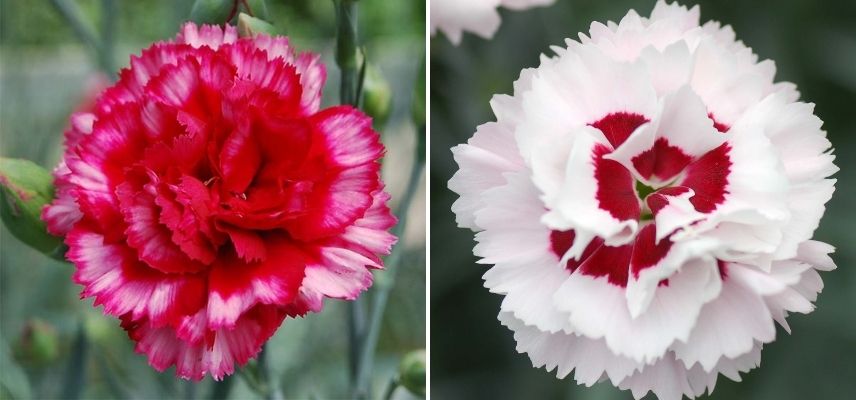 Dianthus plumarius ‘Devon Magic’ and ‘Coconut Sundae’
Dianthus plumarius ‘Devon Magic’ and ‘Coconut Sundae’
Read also
Carnation: planting, care, sowing tipsAccording to the shape of the flowers
Carnations have the unique characteristic of being uniflorous or several-flowered. This means that the flowers appear either solitary at the tip of a stem or in a bouquet of several flowers. The carnation flower can come in various shapes and the petals can be fringed, crinkled, or dentate:
Single flower
Composed of 5 petals, the ‘Couching Carnation ‘Rosea’ and Dianthus ‘La Bourboule Alba’ are very finely dentate. Very slightly fringed, the Dianthus spiculifolius rivals the highly fringed Dianthus superbus ‘Primadonna’ with its feathery effect.
Semi-double flower
Many sweet carnations have semi-double flowers with more or less dentate petals, such as Dianthus plumarius ‘Scent First Raspberry Sundae’, ‘Gran’s Favourite’, and ‘Scent First Tickled Pink’. We can also mention the hybrid carnations Dianthus ‘Evening Star’, Dianthus allwoodii ‘Romeo’, and ‘Alice’.
Double flower
Featuring flowers adorned with numerous petals, the Dianthus plumarius ‘Mrs Sinkins’, delicately dentate, is very elegant. The Dianthus ‘Pop Star’ forms beautiful rounded pom-poms. Finally, the ‘Sweet Carnation ‘Haytor White’ is particularly tousled and highly fringed. The Grenoble Carnation ‘Whatfield Gem’ plays the originality card by being crinkled.
 Dianthus superbus ‘Primadonna‘ (photo Tanaka Juuyoh), Dianthus plumarius ‘Scent First Raspberry Sundae‘ and Dianthus plumarius ‘Haytor White’
Dianthus superbus ‘Primadonna‘ (photo Tanaka Juuyoh), Dianthus plumarius ‘Scent First Raspberry Sundae‘ and Dianthus plumarius ‘Haytor White’
Discover other Dianthus - Pinks
View all →Available in 0 sizes
Available in 2 sizes
Available in 2 sizes
Available in 2 sizes
Available in 1 sizes
Available in 2 sizes
Available in 2 sizes
Available in 1 sizes
Available in 2 sizes
Available in 1 sizes
According to the colour of the foliage
One of the main advantages of Perennial Carnations is their evergreen foliage, forming beautiful, decorative clumps in winter. Some will have a carpet habit, while others will be more bushy. The leaves are always very linear and lanceolate. Note that dwarf Carnations have shorter leaves than other Dianthus. Overall, the Carnation offers us three foliage colours: green, grey, and purple. Darker, bluish, and silvery shades emerge, making the Dianthus even more attractive.
Green foliage carnations
In the category of green foliage, there are many delta Carnations, such as Dianthus deltoides ‘Rosea’, ‘Flashing Light’, and ‘Brilliant’. The Bearded Carnation Dianthus barbatus ‘Jolt Pink Magic’ and the Chartreuse Carnation Dianthus carthusianorum both display dark green leaves. Finally, the Sand Carnation Dianthus arenarius is adorned with soft, fresh green foliage.
Greyish-blue green foliage carnations
Very often, Dianthus have greyish-blue green foliage, with a large majority of the Sweet William varieties. The Dianthus plumarius ‘Lily the Pink’ is a good example. The Alpine Carnation Dianthus allwoodii ‘Fusilier’ and Dianthus allwoodii ‘Romeo’ also stand out with their grey-green leaves, just like the dwarf Carnation Dianthus ‘Pop Star’ and the carpet variety Dianthus ‘La Bourboule Alba’ in blue-green.
Purple foliage carnations
Finally, the Dianthus barbatus nigrescens ‘Sooty’ makes a statement in the garden with its surprising dark foliage, green with blackish and reddish reflections. Its mahogany vegetation highlights its intensely chocolate-red flowers!

The colour of Carnation leaves varies from green to grey-green or purple: Dianthus deltoides ‘Flashing Light’, Dianthus plumarius ‘Lily the Pink’, and Dianthus barbatus nigrescens ‘Sooty’ (photo Trisha)
Read also
Drying carnationsAccording to height
Ideal for dry gardens or vicar’s gardens, Carnations have different habits depending on the species and can be more or less compact, groundcover, upright, or arching. Dianthus can be classified into three size categories:
Dwarfs – between 10 cm and 20 cm tall
Among the smallest creeping Dianthus, we can mention the lawn-forming Dianthus plumarius ‘Warden Hybrid’, the hybrid Carnation ‘Berlin Snow’, and the Pentecost Carnation ‘Splendens’ not exceeding 15 cm in height, with a spread of about 30 cm.
→ Discover our advice sheet 10 carnations to plant at the edge of a border
Mediums – between 30 cm and 60 cm tall
Next, the species and varieties that range in height from 30 to 60 cm are the most numerous. With their upright habit, these Carnations are perfect for borders or beds: Dianthus carthusianorum, and the sweet-scented Carnations ‘Moulin Rouge’ or ‘Mrs Sinkins’. Their clump generally spreads 20 to 40 cm at most.
Tall – between 60 cm and 1 m tall
Finally, it is the Florist’s Carnation, Dianthus caryophyllus, that includes the largest varieties among its ranks.
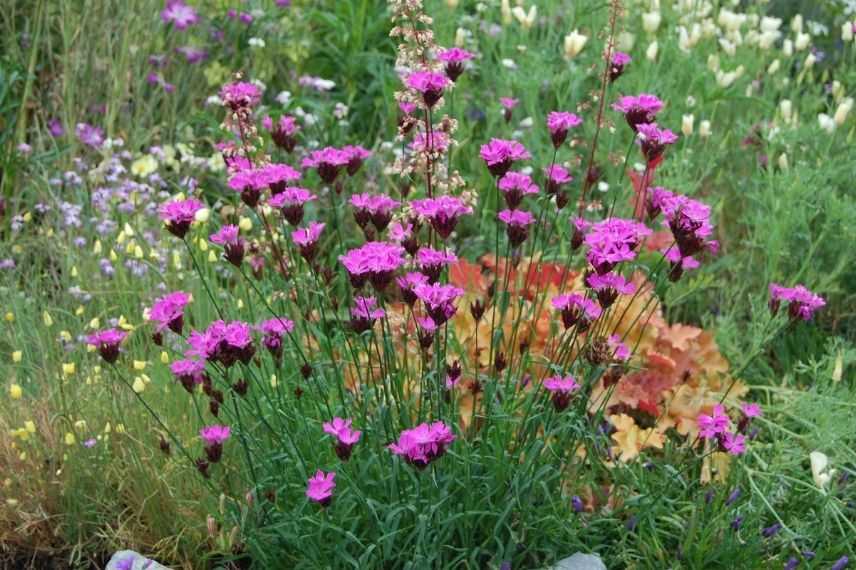
Upright habit of Dianthus carthusianorum (photo FarOutFlora)
According to the fragrance
- Carnations provide us with their abundant flowering for many months. Their flowers emit a sweet and strong spicy fragrance, sometimes sweet, reminiscent of cloves. Among the most fragrant are Dianthus plumarius ‘Doris’ in salmon pink, the Dianthus gratianopolitanus ‘Eydangeri’ with a strong scent, and Dianthus plumarius ‘Pretty Flamingo’ with sweetly fragrant pom-poms.
- Chinese Carnations, grown as annual plants, are lightly scented (Dianthus chinensis ‘Chianti’ and Dianthus chinensis heddewigii ‘Victoriana’), or not at all for some recent cultivars.
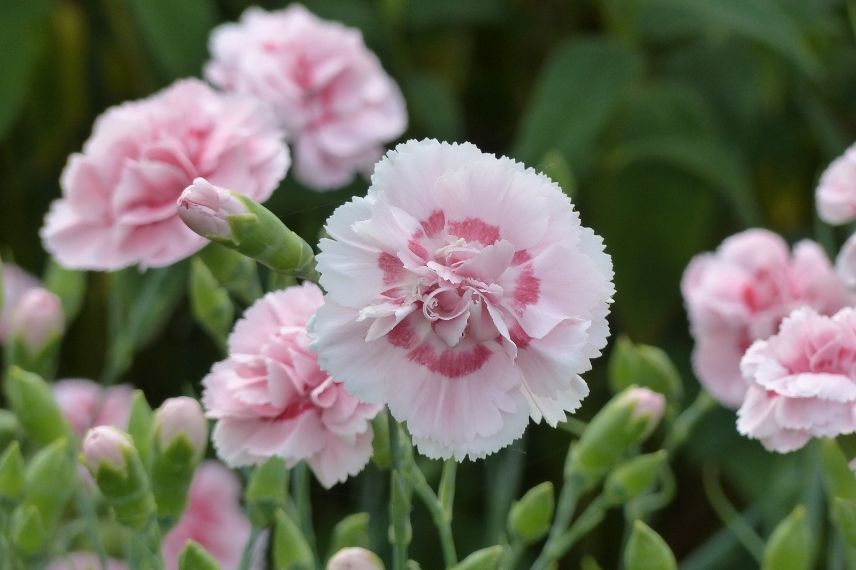
Dianthus plumarius ‘Doris’
According to the flowering period
Old varieties of Pinks have a rather short flowering period, blooming for 2 to 3 weeks in June or July. In contrast, modern Pinks bloom for a longer duration, typically from May to September. Some early varieties of Dianthus already show their flowers in April, such as Dianthus plumarius ‘Passion Hot Red’. For others, the flowering can even extend until October, as is the case with the Pentecost Pinks Dianthus gratianopolitanus ‘Badenia’ and ‘Kahori’, which are repeat flowering, as well as the superb Pink ‘Suntory Pink’.
According to hardiness
Renowned for their good hardiness, most Pinks can withstand temperatures down to -15°C. Among the hardiest that can face temperatures below -15°C are the Cheddar Pinks Dianthus deltoides ‘Flashing Light’, ‘Brilliant’ and ‘Rosea’; some dwarf Pinks Dianthus alwoodii ‘Fusilier’, Dianthus ‘Evening Star’ and Dianthus squarrosa ‘Berlin Snow’, and finally the Carnations of Pentecost Dianthus gratianopolitanus ‘Whatfield Gem’ and ‘Eydangeri’. The least hardy Pinks are generally those grown as annual or biennial plants: for example, Dianthus superbus ‘Suntory Pink’ or Dianthus barbatus ‘Jolt Pink Magic’ which only withstand temperatures down to -5°C.
According to their lifespan
- The lifespan of Carnations varies depending on the species. The Dianthus with a life cycle of 1 or 2 years are annual or biennial plants. With a short life, the Sweet William (Dianthus barbatus), the Carnation (Dianthus caryophyllus), and the China Pink (Dianthus chinensis) are included.
- The most well-known perennial Carnations are the Pinks (Dianthus plumarius), the Pentecost Carnations also known as the Grenoble Carnations (Dianthus gratianopolitanus), the Maiden Pink or the Heath Pink (Dianthus deltoides), and finally the Sand Pink (Dianthus arenarius) and the Chartreuse Pink (Dianthus carthusianorum).
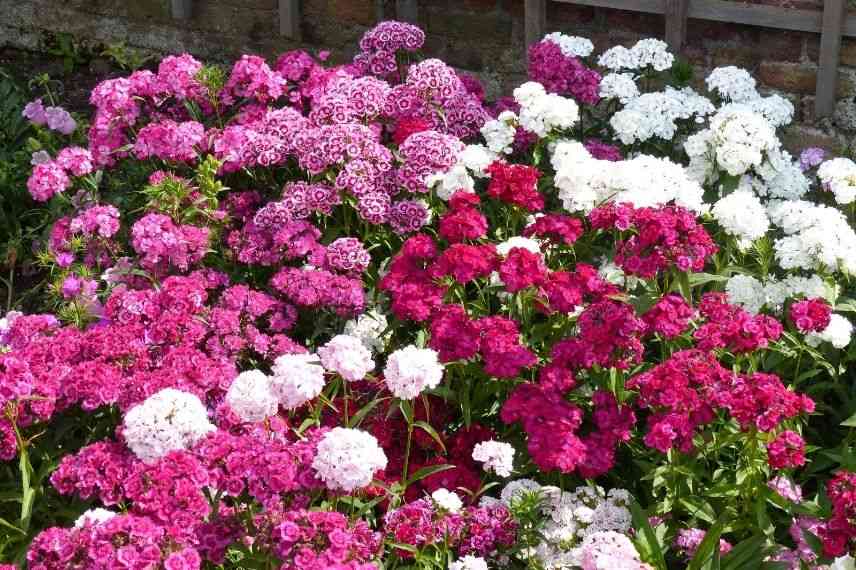
Annual and biennial Carnations in mix
According to the use
- To flower a terrace, it is possible to grow the Carnation in a pot. Place its container in a bright, warm location, along a path or near an entrance to welcome your visitors with a sweet fragrance. All Carnations can be planted in containers, troughs, or pots.
- The tallest Carnations take their place in the middle of sunny borders or mixed beds, planted in masses: Dianthus superbus, Dianthus plumarius ‘Lady in Red’ and Dianthus plumarius ‘Devon Dove’.
- Dwarf and medium-sized Carnations, such as Dianthus ‘Evening Star’, Dianthus plumarius ‘David’ and Dianthus plumarius ‘Heidi’, should be placed more towards the front, surrounded by low plants to highlight their flowering clumps. With its bucolic style, the Carnation is perfect for naturalistic gardens, adding colour and lightness.
- Well resistant to heat and drought, the Carnation is perfectly suited for planting on a well-drained slope, a low wall, or in a dry rock garden. For example, Dianthus ‘Cranmere Pool’, Dianthus ‘Scent First Memories’ and Dianthus plumarius ‘Desmond’ will thrive there.
- An excellent plant for making cut flower arrangements, place the Carnation in the vegetable garden alongside other cut flowers. Prefer the charming Carnations with beautiful pompom flowers or the poet’s Carnations with generous blooms.
 Carnations in mass, border, and dry rock garden</caption]
Carnations in mass, border, and dry rock garden</caption]
- Subscribe!
- Contents
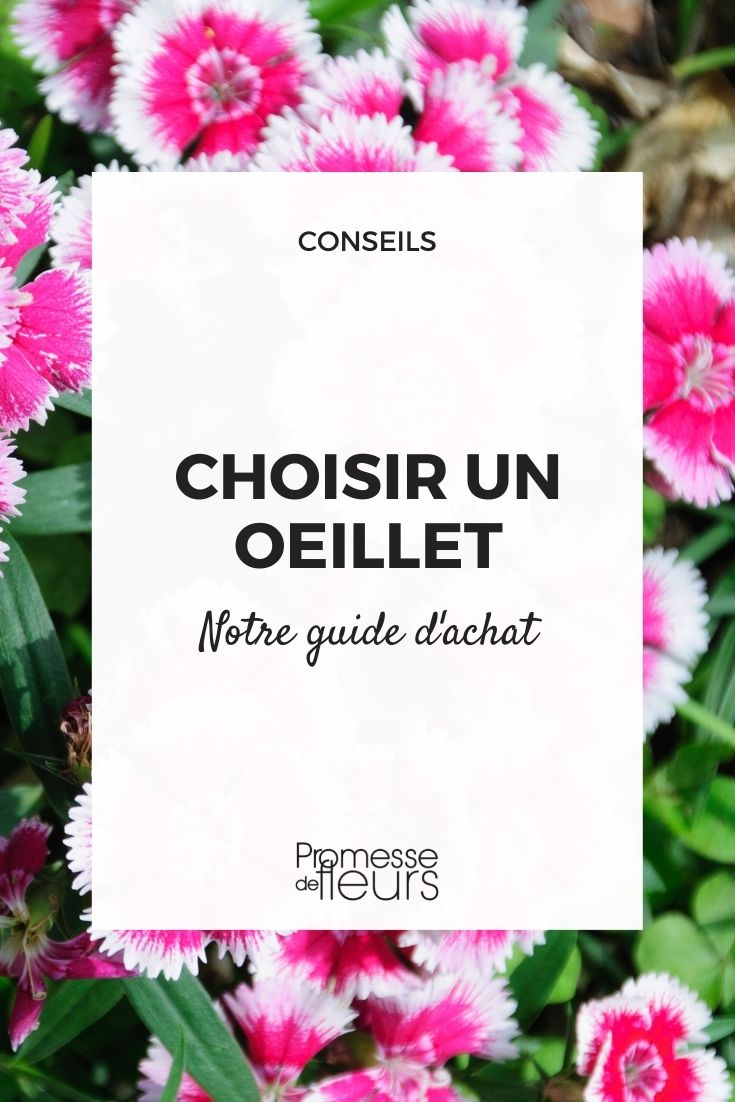































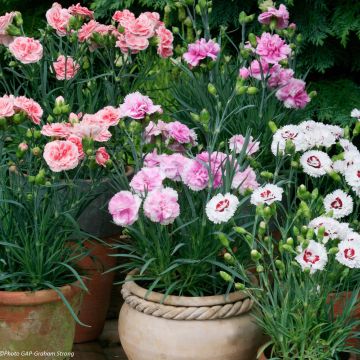
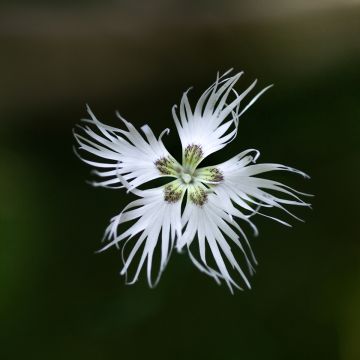
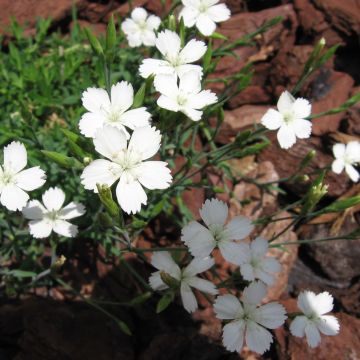
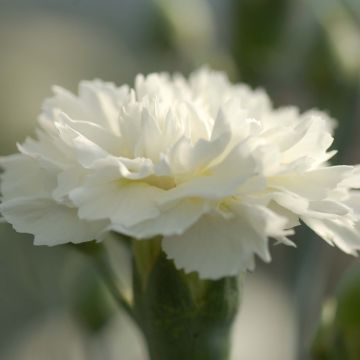
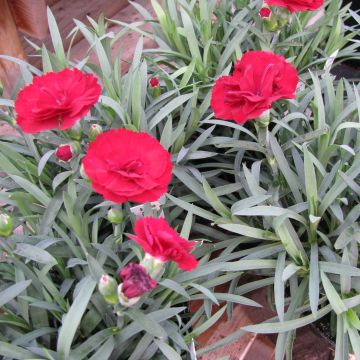
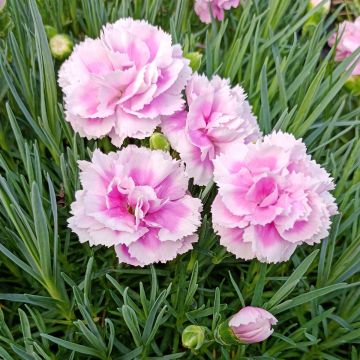
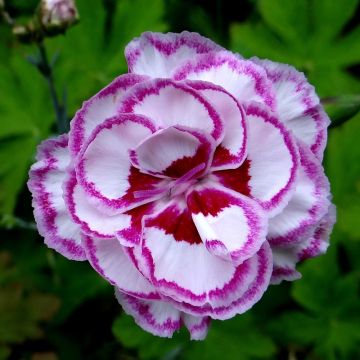
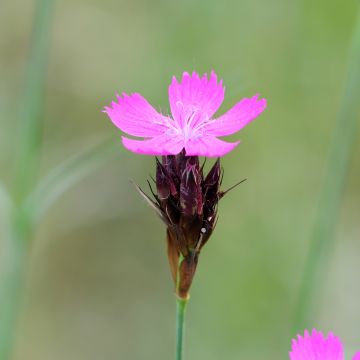
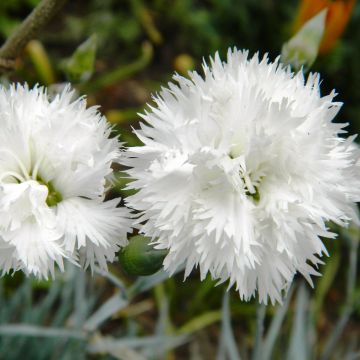
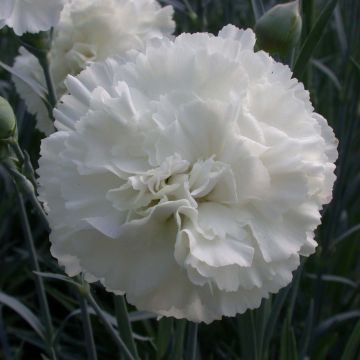
Comments